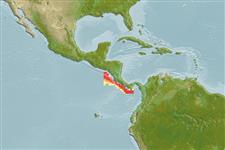Classification / Names
ชื่อสามัญ | ชื่อพ้อง | Catalog of Fishes(สกุล, ชนิด) | ITIS | CoL | WoRMS | Cloffa
sub class Elasmobranchii (ฉลามและกระเบน) (sharks and rays) >
Squaliformes (Sleeper and dogfish sharks) >
Etmopteridae (Lantern sharks)
Etymology: Etmopterus: Greek, ethmos, -ou = sieve or ethmoides bone + Greek, pteron = wing, fin (Ref. 45335); benchleyi: Named for Peter Benchley, author of the movie Jaws and subsequently an avid shark conservationist..
Environment: milieu / climate zone / depth range / distribution range
นิเวศวิทยา
เกี่ยวกับทะเล,น้ำเค็ม; ระดับความลึก 836 - 1443 m (Ref. 106129). Deep-water; 13°N - 6°N, 89°W - 80°W (Ref. 106129)
Eastern Pacific Ocean: from Nicaragua south to Panama.
ขนาด / น้ำหนัก / Age
Maturity: Lm ? range ? - ? cm
Max length : 32.5 cm TL เพศผู้/กระเทย; (Ref. 106129); 51.5 cm TL (female)
Short description
สัณฐานวิทยา | ความยาวต่างๆ
This moderately large species is distinguished by the following set of characters: short snout with pre-narial length 2.9% TL (2.9-4.0%) and pre-oral length 7.8% TL (6.9-9.0%); broad mouth strongly arched, width 1.2 (1.0-1.5) times into pre-oral length; dentition show strong disjunct dignathic heterodonty with upper teeth comprised of single median cusp, flanked by 1-2 pairs of lateral cusplets, where lower teeth with low, distally-inclined cusps lacking serrations and a low posterior blade; dermal denticles are short, slender, with slightly hook-like conical crowns; denticles below second dorsal fin in irregular patch densities and align into rows along the ceratotrichia of the fins; denticles dense around the eyes and gill openings, sparse to bare on ventrum of snout tip and around mouth; first and dorsal fins similar in size; the second-dorsal-fin spine 1.7 (1.6-2.3) times longer than first-dorsal-fin spine; the second-dorsal-fin spine height greater than second-dorsal-fin apex; interdorsal-fin space is moderately long, 23.1% TL (19.2-21.4%); body color uniformly black, the anteroposteriorly oblong narrow pineal window apparent (Ref. 106129)
The larger individuals of this species were collected at greater depth than smaller specimens, suggesting a positive relationship between size and depth, as has been observed in E. princeps. The largest paratype (51.5 cm TL) contains five ova ranging from 25.6 to 34.2 mm, with no embryos apparent. The immature male paratype has claspers at the earliest stage of development, suggesting that maturity for males is attained at a greater size. Viviparous with litter sizes apparently consist of at least 5 pups with post-partum lengths less than 177 mm TL (Ref. 106129).
Life cycle and mating behavior
วัยเจริญพันธุ์ | การสืบพันธุ์ | การวางไข่ | เซลสืบพันธ์ของเพศเมีย(ไข่) | ความดกของไข่ | ตัวอ่อน
Vásquez, V.E., Ebert. D.A. and D.J. Long, 2015. Etmopterus benchleyi n. sp., a new lanternshark (Squaliformes: Etmopteridae) from the central eastern Pacific Ocean. J. Ocean Sci. Found. 17:43-55. (Ref. 106129)
IUCN Red List Status (Ref. 130435)
Threat to humans
Harmless
Human uses
ข้อมูลเพิ่มเติม
ชื่อสามัญชื่อพ้องกลไกการเผาผลาญพลังงานผู้ล่าการศึกษาเกี่ยวกับผลกระทบของสารประกอบทางเคมีที่เป็นอันตรายต่อสิ่งมีชีวิต ประชากร และสิ่งแวดล้อมการสืบพันธุ์วัยเจริญพันธุ์การวางไข่การรวมกลุ่มวางไข่ความดกของไข่เซลสืบพันธ์ของเพศเมีย(ไข่)Egg development
Age/SizeการเจริญเติบโตLength-weightLength-lengthLength-frequenciesความยาวต่างๆสัณฐานวิทยาตัวอ่อนพลวัตของสัตว์น้ำวัยอ่อนการทดแทนที่อุดมสมบรูณ์BRUVS
อ้างอิงการเพาะเลี้ยงสัตว์น้ำประวัติการเพาะเลี้ยงสัตว์น้ำสายพันธุ์พันธุศาสตร์ElectrophoresesอัตราพันธุกรรมโรคการแปรรูปNutrientsMass conversion
ผู้ร่วมมือรูปภาพหลายรูปStamps, Coins Misc.เสียงปลามีพิษ เช่น ปลาปักเป้าความเร็วรูปแบบการว่ายน้ำพื้นที่เหงือกOtolithsสมองวิสัยทัศน์
เครื่องมือ
Special reports
Download XML
แหล่งที่มาจากอินเตอร์เน็ต
Estimates based on models
Preferred temperature (Ref.
123201): 3.3 - 3.5, mean 3.4 °C (based on 6 cells).
Phylogenetic diversity index (Ref.
82804): PD
50 = 0.5000 [Uniqueness, from 0.5 = low to 2.0 = high].
Bayesian length-weight: a=0.00380 (0.00191 - 0.00758), b=3.09 (2.92 - 3.26), in cm total length, based on LWR estimates for this Genus-body shape (Ref.
93245).
ระดับชั้นอาหาร (Ref.
69278): 4.2 ±0.6 se; based on size and trophs of closest relatives
ความสามารถในการกลับคืนสู่ปกติ (Ref.
120179): ต่ำ, เวลาต่ำสุดที่จะทำให้ประชากรเพิ่มขึ้นเป็น 2 เท่าใช้เวลา 4.5 - 14 ปี (Preliminary K or Fecundity.).
Fishing Vulnerability (Ref.
59153): Moderate vulnerability (41 of 100).
